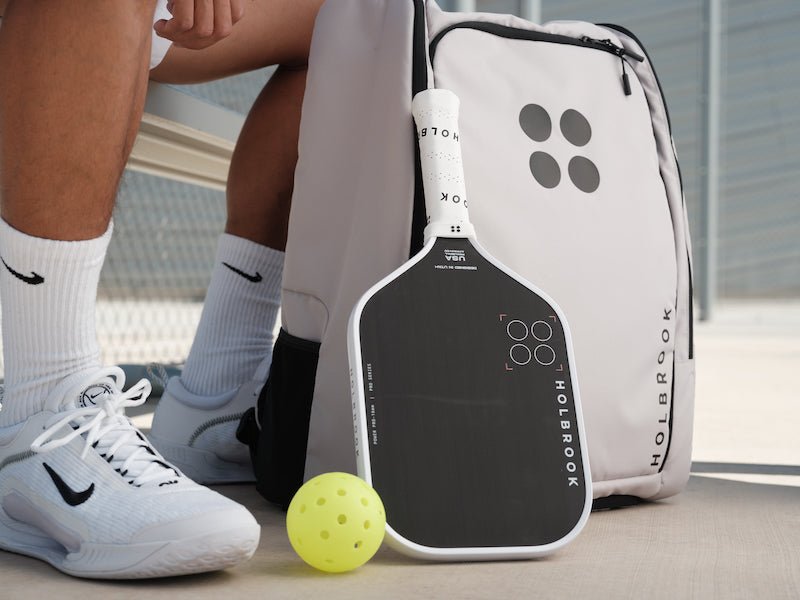Pickleball Scoring
Pickleball has rapidly gained popularity in recent years, captivating the hearts of sports enthusiasts worldwide. This unique paddle sport, often described as a combination of tennis, badminton, and table tennis, offers players of all ages and skill levels an exhilarating experience on the court. While the rules and gameplay may seem straightforward to newcomers, understanding the intricacies of pickleball scoring is essential for both enjoying the game and strategizing for victory.
In this comprehensive guide, we aim to demystify pickleball scoring and equip you with the knowledge needed to navigate the scoring system with confidence. Whether you're a beginner stepping onto the court for the first time or an experienced player looking to refine your skills, grasping the fundamentals of pickleball scoring is crucial.
We'll begin by providing a brief overview of pickleball basics, ensuring everyone is on the same page with the game's core principles and terminology. From there, we'll delve into the specifics of pickleball scoring, unraveling the intricacies of point accumulation, serving rotations, and the elusive "side out." Understanding the various scoring methods, including the traditional and rally scoring systems, will further enhance your comprehension of the game.
Moreover, we'll explore common scoring situations and strategies, such as deuce and advantages, serving techniques, and defensive/offensive gameplay approaches. Armed with this knowledge, you'll be able to make informed decisions on the court, seize scoring opportunities, and outmaneuver your opponents.
So, whether you're a casual player seeking a fun pastime or a competitive athlete aiming to dominate tournaments, this blog will serve as your go-to resource for unraveling the intricacies of pickleball scoring. Let's dive in, unlock the secrets of this captivating sport, and elevate your pickleball experience to new heights. Get ready to master the art of scoring and revel in the thrill of pickleball!

Pickleball Basics
Introduction to the game of pickleball
Pickleball, a sport that originated in the mid-1960s, has captured the attention of millions of players around the globe. Combining elements from various racquet sports, it offers a unique and exciting experience on the court. Played on a rectangular court with a low net, pickleball can be enjoyed both indoors and outdoors. The game features two to four players divided into two teams, positioned on opposite sides of the net.
Overview of pickleball court dimensions and equipment
To fully grasp the scoring dynamics, it's important to familiarize yourself with the pickleball court and equipment. The court measures 20 feet wide and 44 feet long for doubles play, and slightly narrower for singles. The net stands at 36 inches at the sidelines and dips to 34 inches at the center. These dimensions provide the perfect setting for strategic play and fast-paced rallies.
Players employ specialized paddles made of composite materials to strike the ball like our Mav Pro pickleball paddle. The ball itself resembles a perforated plastic wiffle ball, designed to slow down its speed for better control and extended rallies. The paddles and balls are carefully crafted to enhance gameplay while maintaining a balance between power and precision.
Explanation of pickleball gameplay rules and terminology
To understand scoring, it's crucial to grasp the fundamental rules and terminology of pickleball. Here are some key aspects:
- Serve: Each rally starts with a serve. The serving team stands behind the baseline and serves diagonally to the opponent's service court. The serve must clear the non-volley zone (the kitchen) and land in the opponent's court. A fault occurs if the serve is out of bounds or does not clear the kitchen.
- Double Bounce Rule: After the serve, both teams must let the ball bounce once on each side before playing a volley (hitting the ball in the air). This rule ensures a fair and balanced game by giving all players an opportunity to engage in the rally.
- Non-Volley Zone (The Kitchen): A seven-foot area adjacent to the net on both sides is designated as the non-volley zone or the kitchen. Players are not allowed to hit the ball out of the air within this zone, promoting strategic placement and minimizing the dominance of volleys.
- Scoring: Points are scored by the serving team only. If the serving team wins a rally, they score a point and continue serving. If the receiving team wins a rally, they earn the right to serve. The first team to reach 11 points (or an alternative predetermined number) with a lead of at least two points wins the game.
By understanding the basic pickleball rules and terminology of pickleball, you'll be prepared to dive deeper into the scoring intricacies and develop effective strategies to gain an edge on the court.
Understanding Pickleball Scoring
Scoring System Overview
In pickleball, the scoring system is designed to reward teams for winning rallies and maintain a fair competition. The scoring method used in most games is known as rally scoring. Unlike traditional scoring systems where only the serving team can earn points, rally scoring allows both serving and receiving teams to score points.
- Introduction to Rally Scoring: In rally scoring, points can be won by either team, regardless of who serves. This adds an exciting dynamic to the game, as every rally becomes an opportunity to earn a point.
- Importance of Winning Points to Score: Every point won is crucial in pickleball. The team that wins a rally not only earns a point but also retains the serve, giving them an opportunity to continue accumulating points.
Serving and Receiving
- Explanation of the Serve Rotation: In pickleball, serving is done diagonally, starting from the right-hand side of the court. After each point, the server switches sides, serving from the left-hand side. The serving rotation ensures fairness and equal opportunities for all players.
- Discussion of the Double Bounce Rule: The double bounce rule mandates that the serve and the return of serve must both bounce once on each side before volleys are allowed. This rule prevents excessive dominance by skilled players and promotes longer rallies.
Points and Side Out
- Clarification of Scoring Terminology: Understanding scoring terminology is essential in pickleball. A "point" is awarded when a team wins a rally, and it is used to track the score. A "side out" occurs when the serving team loses a rally, resulting in a change of serve to the opposing team.
- Description of Point Accumulation: Points are accumulated throughout the game, with each team earning a point for every rally they win. It's important to note that the serving team is the only team that can score points. However, if the receiving team wins a rally, they gain the right to serve and have an opportunity to score.
Winning a Game
-
Determining the Number of Points Required to Win: In traditional pickleball games, the first team to reach 11 points wins the game. However, some variations may have different point requirements, such as 15 or 21 points.
-
Exploration of the Concept of a Winning Margin: To win a game, a team must have a lead of at least two points over the opposing team. This rule ensures that the winning team not only reaches the required number of points but also maintains a clear advantage.
Understanding how scoring works in pickleball is fundamental to your success on the court. By grasping the dynamics of serving, receiving, point accumulation, and winning a game, you'll be better equipped to devise winning strategies, anticipate crucial moments, and make tactical decisions that can turn the tide in your favor. So, let's dive deeper into the scoring methods and explore the different variations used in pickleball games.
Pickleball Scoring Methods
Traditional Scoring System
- Explanation of the 11-Point Format: In traditional pickleball scoring, games are played to 11 points. The first team to reach 11 points with a lead of at least two points wins the game.
- Discussion of the Win by Two Rule: The win by two rule ensures that a team must have a clear advantage over their opponents to secure victory. If the score is tied at 10-10, the game continues until one team has a two-point lead.
Rally Scoring System
- Introduction to the Rally Scoring Format: In the rally scoring system, points can be earned by both the serving and receiving teams. Each rally is an opportunity to score, adding to the excitement of the game.
- Comparison of Rally Scoring with Traditional Scoring: Rally scoring eliminates the need for side-outs and provides more opportunities for teams to accumulate points, making games faster-paced and more dynamic.
Tournament Scoring Variations
-
Overview of Different Scoring Methods: In tournament play, there can be variations in scoring methods. Some tournaments may use best-of-three formats or timed matches, where the team with the most points at the end of a specified time wins.
-
Explanation of How Variations Affect Scoring Strategies: Different scoring variations require players to adapt their strategies accordingly. Understanding the scoring format of a tournament is essential for effective gameplay and success.

Common Scoring Situations and Strategies
Deuce and Advantages
- Definition of Deuce: When the score reaches 10-10 in traditional scoring, it is referred to as a deuce. This marks a critical moment in the game, as both teams strive to secure a two-point lead for victory.
- Explanation of Advantages: When a deuce occurs, players have the opportunity to gain an advantage by winning consecutive points. An advantage is earned when a team wins a point after a deuce, putting them one point away from winning.
Serving Strategies
- Discussion of Serving Techniques: Serving is a crucial aspect of pickleball scoring. Different serving techniques, such as power serves, spin serves, or placement serves, can be employed to gain an advantage and put pressure on the opponents.
- Tips for Capitalizing on the Serve: Serving strategically can create scoring opportunities. By varying the placement, speed, and spin of your serves, you can disrupt your opponent's rhythm and increase your chances of winning points.
Defensive and Offensive Strategies
- Overview of Defensive Tactics: Effective defense is essential in pickleball. Strategies such as proper positioning, anticipation, and accurate shot placement can help you neutralize your opponent's attacks and prolong rallies.
- Explanation of Offensive Strategies: Offensive strategies involve taking control of the rally and actively seeking opportunities to score. Techniques like dinking, attacking the kitchen line, and setting up your partner can help you create openings and put your opponents on the defensive.
Conclusion
Understanding pickleball scoring is fundamental to enjoying the game and strategizing for success. By grasping the nuances of serving, receiving, point accumulation, and various scoring methods, you'll be better equipped to make informed decisions on the court and adapt your strategies to different situations.
Pickleball scoring systems, whether traditional or rally scoring, offer their own unique dynamics and challenges. The deuce and advantage situations provide thrilling moments of suspense, while serving and defensive/offensive strategies allow players to leverage scoring opportunities.
As you continue to explore the world of pickleball, practice your skills, and immerse yourself in the sport, remember that scoring is just one piece of the puzzle. Ultimately, pickleball is about camaraderie, physical activity, and having fun. So, apply your newfound knowledge, enjoy the thrill of the game, and savor the exciting moments that pickleball has to offer. Get out on the court and let the scoring begin!




